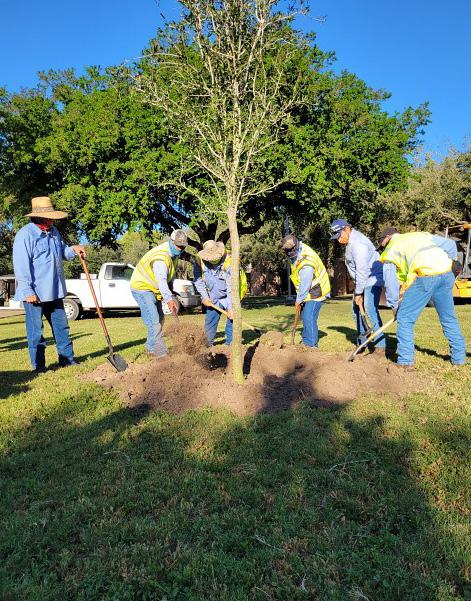
2 minute read
CAMPUS TREE CARE PLAN
3.02.0 TREES WITHIN LOC ARE ULTIMATELY THE PROPERTY OF UTRGV
All attempts shall be made to ensure survivability of trees in regards to construction impacts. Including:
Advertisement
3.02.1 Continuous inspection of tree protection fencing installed per university specifications and approved site plan (by contracted landscape architects and/or arborist and general contractor).
3.02.2 Any encroachments into tree protection fencing and CRZs shall be brought to the attention of the project manager and/or construction inspector, contracted landscape architects and/or arborist, or landscape services representative. Refer to section 2.05.3
3.02.3 Deviations from approved tree preservation plans will occur only with written authority from contracted landscape architects and/or arborist or UTRGV landscapeservices representative.
3.03.0 CRITICAL ROOT ZONE (CRZ) MANAGEMENT
3.00.0 TREE PROTECTION DURING CONSTRUCTION
3.01.0 Projects on the UTRGV campuses, shall adhere to specifications based on the most current editions of the following:
3.01.1 American National Standards Institute (ANSI) A300– 05 Management of Trees and Shrubs during Site Planning, Site Development, and Construction (2012).
3.01.2 ANSI z133.1 Safety Standards
3.01.3 Related ISA Best Management Practices (BMP’s)
Any roots two inches (2”) or greater severed by construction activities shall be pruned flush with the soil. Roots severed shall be backfilled with quality soil or compost as soon as possible. Cuts to oak roots shall be made using disinfected tools and painted when finished. If exposed roots are not backfilled within 48 hours, cover them with organic material in a manner that reduces soil temperature and minimizes water loss due to evaporation. Excavations within CRZ shall be first assessed by means of air excavation. Utilizing a compressed air tool significantly decreases damage to roots. Locating roots using this method allows for proper root pruning and preservation techniques that will increase the chance of survival of the tree.
3.03.1 Air Excavation Specifications:
3.03.11 A compressor-powered air excavation tool shall be used to “pothole” (probe soil to certain depth in search of root material) proposed excavation areas.
3.03.12 Roots 2” and greater will be exposed and cut cleanly back to existing soil (wound paint and disinfected tools required for all oaks).
3.03.13 A quality topsoil and/or compost shall be used as backfill in areas where roots are present.
3.03.14 Coordinate with the requirements of the proposed planting soil section for modifications to the soil within the root zone of existing trees.
3.03.2 Any trenching required for the installation of landscape irrigation shall be installed as far from existing tree trunks as possible, and must be outside of quarter CRZ.
3.03.3 No soil greater than 4 inches shall be permitted within the half CRZ of trees. No soil or mulch is permitted on the root flare of any tree.
3.03.4 Pruning to provide clearance for structures, vehicular clearance and equipment shall take place before damage occurs (ripping of branches etc.).
3.03.5 All pruning shall be performed to ASNI A300-01 Pruning Standards (2014), ANSI Z133.1 Safety Standards, and be completed by tree care professionals with a minimum of an ISA Certified Tree Worker on site. No more than 25% of the tree ay be pruned. Anything abover 25% must be approved by contracted landscape architects and/ or aborist.
3.03.6 Contracted landscape architects and/or arborist shall approve any modifications to the tree protection plan.
3.03.7 Removal of Hardscape Areas from CRZ Special care shall be taken when removing sidewalks, streets, pavers, etc., from within CRZ. This will include but not be limited to:
3.03.71 Saw cutting and hand removal of materials within CRZ
3.03.72 Reduced heavy equipment access within CRZ
3.03.73 Installation of mulch (4-6 inches) within CRZ for root protection.









